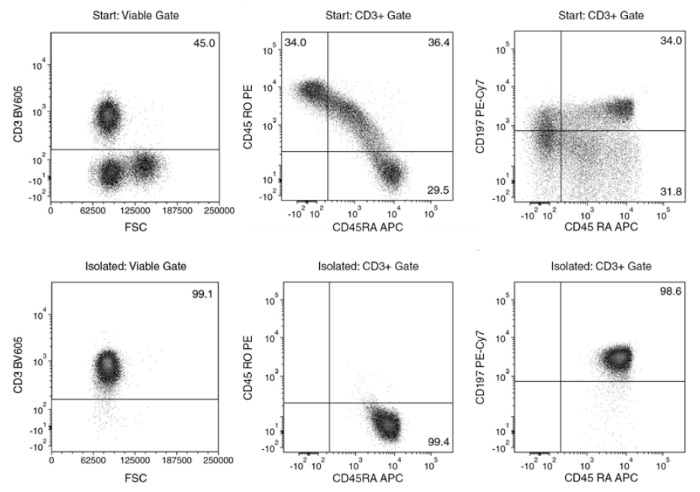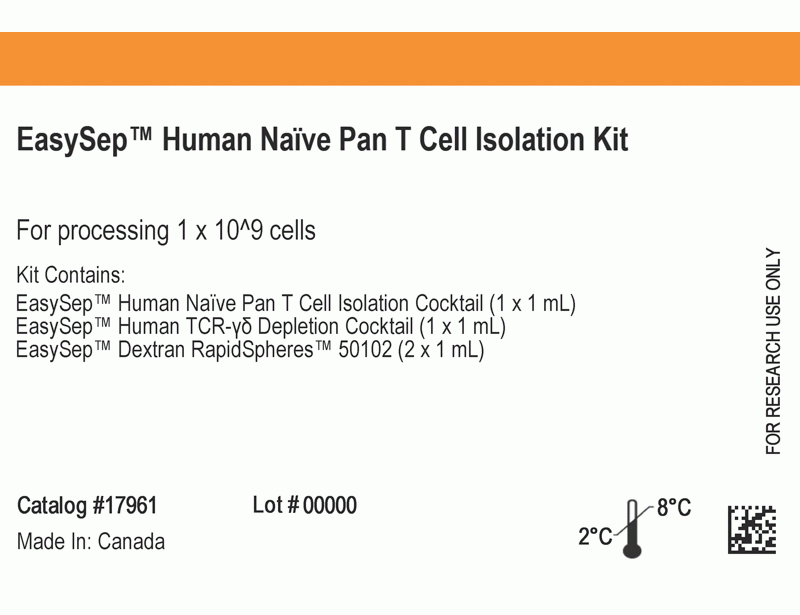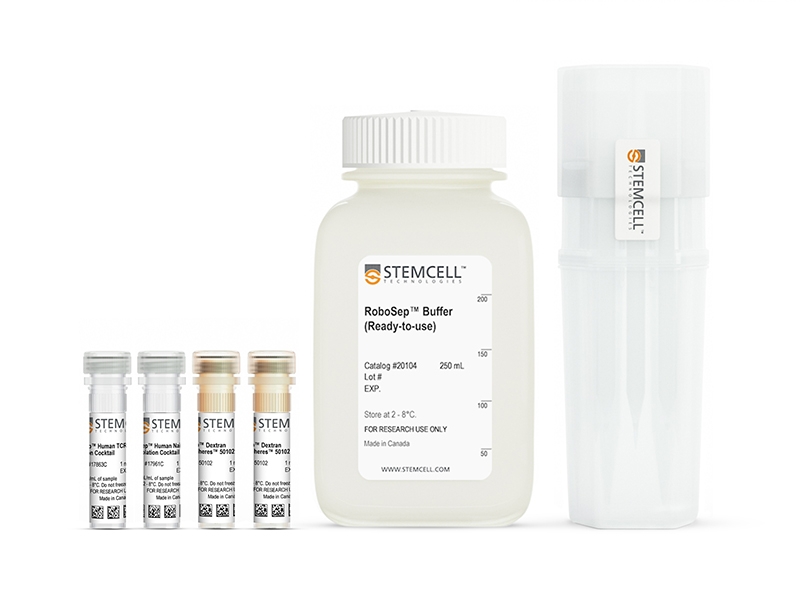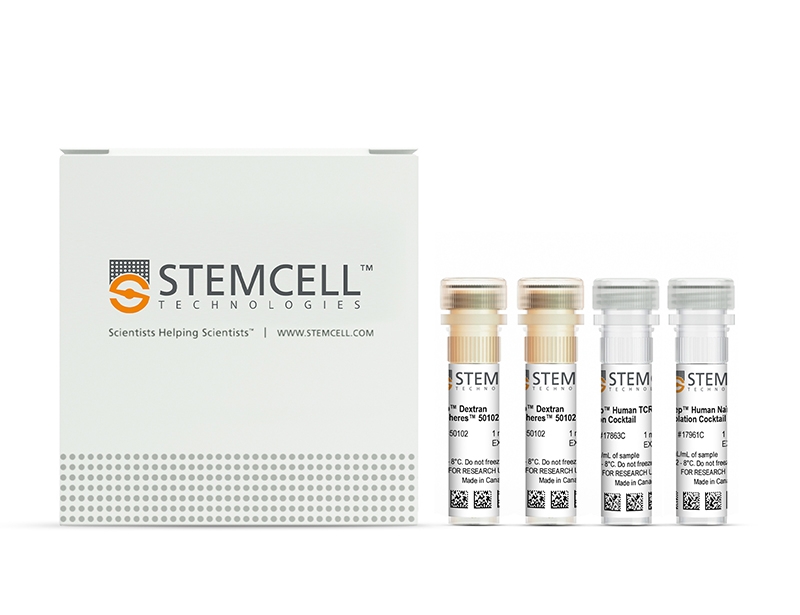EasySep™ Human Naïve Pan T Cell Isolation Kit
Immunomagnetic negative selection kit
概要
The EasySep™ Human Naïve Pan T Cell Isolation Kit is designed to isolate naïve pan T cells from fresh or previously frozen human peripheral blood mononuclear cells or washed leukapheresis samples by immunomagnetic negative selection. The EasySep™ procedure involves labeling unwanted cells with antibody complexes and magnetic particles. The magnetically labeled cells are separated from the untouched desired cells by using an EasySep™ magnet and simply pouring or pipetting the desired cells into a new tube.
Advantages
• Fast, easy-to-use and column-free
• Up to 98% purity
• Isolated cells are untouched
• Up to 98% purity
• Isolated cells are untouched
Components
- EasySep™ Human Naïve Pan T Cell Isolation Kit (Catalog #17961)
- EasySep™ Human Naïve Pan T Cell Isolation Cocktail, 1 mL
- EasySep™ Human TCR Gamma/Delta Depletion Cocktail, 1 mL
- EasySep™ Dextran RapidSpheres™, 2 x 1 mL
- RoboSep™ Human Naïve Pan T Cell Isolation Kit (Catalog #17961RF)
- EasySep™ Human Naïve Pan T Cell Isolation Cocktail, 1 mL
- EasySep™ Human TCR Gamma/Delta Depletion Cocktail, 1 mL
- EasySep™ Dextran RapidSpheres™, 2 x 1 mL
- RoboSep™ Buffer (Catalog #20104)
- RoboSep™ Filter Tips (Catalog #20125)
Magnet Compatibility
• EasySep™ Magnet (Catalog #18000)
• “The Big Easy” EasySep™ Magnet (Catalog #18001)
• Easy 50 EasySep™ Magnet (Catalog #18002)
• EasyEights™ EasySep™ Magnet (Catalog #18103)
• RoboSep™-S (Catalog #21000)
Subtype
Cell Isolation Kits
Cell Type
T Cells
Species
Human
Sample Source
Leukapheresis, PBMC
Selection Method
Negative
Application
Cell Isolation
Brand
EasySep, RoboSep
Area of Interest
Immunology
技术资料
| Document Type | 产品名称 | Catalog # | Lot # | 语言 |
|---|---|---|---|---|
| Product Information Sheet | EasySep™ Human Naïve Pan T Cell Isolation Kit | 17961 | All | English |
| Product Information Sheet | RoboSep™ Human Naïve Pan T Cell Isolation Kit | 17961RF | All | English |
| Safety Data Sheet 1 | EasySep™ Human Naïve Pan T Cell Isolation Kit | 17961 | All | English |
| Safety Data Sheet 2 | EasySep™ Human Naïve Pan T Cell Isolation Kit | 17961 | All | English |
| Safety Data Sheet 3 | EasySep™ Human Naïve Pan T Cell Isolation Kit | 17961 | All | English |
| Safety Data Sheet 1 | RoboSep™ Human Naïve Pan T Cell Isolation Kit | 17961RF | All | English |
| Safety Data Sheet 2 | RoboSep™ Human Naïve Pan T Cell Isolation Kit | 17961RF | All | English |
| Safety Data Sheet 3 | RoboSep™ Human Naïve Pan T Cell Isolation Kit | 17961RF | All | English |
数据及文献
Data

Starting with fresh PBMCs, the naïve pan T cell content (CD3+CD45RA+CD45RO-CD197+) of the isolated fraction is typically 96.1 ± 2.3% (mean ± SD using the purple EasySep™ Magnet). In the above example, the purities of the start and final isolated fractions are 4.5% and 97%, respectively.
Publications (1)
Science (New York, N.Y.) 2019
LMBR1L regulates lymphopoiesis through Wnt/beta-catenin signaling.
Abstract
Abstract
Precise control of Wnt signaling is necessary for immune system development. In this study, we detected severely impaired development of all lymphoid lineages in mice, resulting from an N-ethyl-N-nitrosourea-induced mutation in the limb region 1-like gene (Lmbr1l), which encodes a membrane-spanning protein with no previously described function in immunity. The interaction of LMBR1L with glycoprotein 78 (GP78) and ubiquitin-associated domain-containing protein 2 (UBAC2) attenuated Wnt signaling in lymphocytes by preventing the maturation of FZD6 and LRP6 through ubiquitination within the endoplasmic reticulum and by stabilizing destruction complex" proteins. LMBR1L-deficient T cells exhibited hallmarks of Wnt/beta-catenin activation and underwent apoptotic cell death in response to proliferative stimuli. LMBR1L has an essential function during lymphopoiesis and lymphoid activation acting as a negative regulator of the Wnt/beta-catenin pathway."



